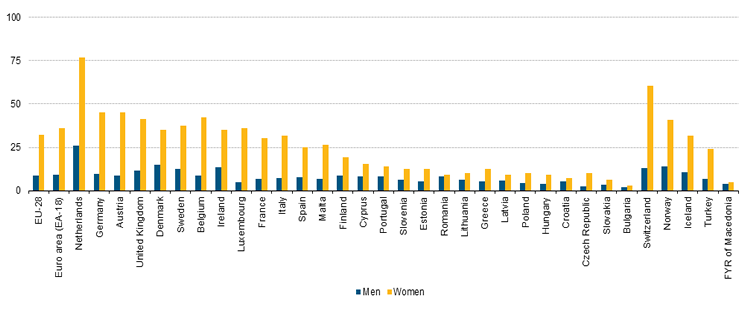
“Mind the gap” –
|
| NOT WORKING 9 TO 5… | Vertical and horizontal segregation of women is only part of the story. Concentration of women in the lower pay bracket can be explained in part by overrepresentation of women in part-time positions (see Figure below), which are mostly lower paid. |
 |
| According to the EWCS, the gender time gap – the difference between men and women’s contributions to the labour market in terms of working time – shows that in the EU27 there is a much higher proportion of women than men working part time (29% and 7% respectively). | Working part time has significant consequences on pay. Between 70% and 80% of employees working part time fall into the low-pay category. However, within the subset of part-time workers, the distribution of low pay is quite even between men and women. |
When looking at the differences in pay between men and women in full-time jobs, a similar pattern emerges: overall, men tend to be overrepresented at the upper end of the income distribution scale and there are roughly twice as many women than men among those on low pay. |
 |
| Source: European Working Conditions Survey 2012 |
| While more women than men tend to work part time, there are twice as many men as women working long hours. | According to the fourth European Working Conditions Survey, 14.9% of EU27 employees work more than 48 hours a week. | When considering the gender difference in terms of working long hours, 20% of all male workers work long hours as compared to 8.5% of all female employees. |
| A SYSTEM MADE FOR MALE BREADWINNERS |
| Over the past 30 years there has been a revolution in women’s lives as women have moved en masse into the workplace. But to do this, women have been forced to fit into a system designed for men. |  |
A culture of working long hours in the office to ‘prove’ your commitment might have been fine when men earned the crust and women looked after hearth and home, but it’s not now. It’s not fine for women, who are also doing most of the unpaid work at home, or for men, who want to be more involved in family life. |
| UNDERVALUING WOMEN'S WORK |
 |
How come a nurse gets paid less than a police officer? How come the people who look after our children get paid less than the people who look after our cars? |
|
| Jobs traditionally done by women are poorly paid and undervalued. Women are concentrated in the five 'Cs' low-paid sectors - cleaning, catering, caring, clerical work and cash registers. |
||
| Historically, women did these jobs for a bit of extra money for the family and they were seen as tasks that come 'naturally' to women, rather than being jobs that require skills and training. | ||
| Given this, it is little wonder that there is still a gender pay gap, women are more likely to live in poverty, have less in savings and pensions and other assets, find it difficult to break the glass ceiling, experience discrimination at work, or to find flexible work that is satisfying and fits with their responsibilities in the home. |
We know the revolution is half-finished. Now we need a new revolution to create truly flexible workplaces and equality at home. |
 |
So that a woman at the top of business doesn’t have to choose between making the school play and making a good impression with the boss. |
| It’s only then that we’ll have a world where a man caring for his young daughter no longer sticks out as the lone dad at the school gates. | So that the people who look after our children are rewarded fairly compared to the people who look after our cars. | |